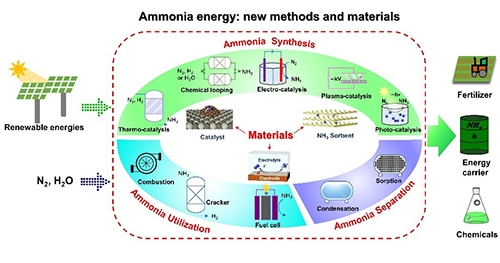Recently, a team led by Professor Chen Ping and Professor Guo Jianping from our group published a progress report on new materials and methods for amino energy storage and conversion.
The storage and transportation of renewable energy is a bottleneck that restricts its large-scale use. Ammonia, as a chemical energy storage carrier, has gradually attracted widespread attention from academia and industry in recent years. This is mainly due to some very important properties of ammonia, such as the absence of carbon in ammonia molecules, ammonia has a high hydrogen storage capacity (17.6 wt%), high gravimetric energy density (22.5 MJ/kg) and high volumetric energy density (11.5 MJ/L), ammonia is easy to store and transport, and there is considerable practical experience in the synthesis and use of ammonia.
Ammonia as an energy source or hydrogen carrier mainly involves three aspects: the green synthesis of ammonia, the separation, storage, and transportation of ammonia, and the utilization and conversion of ammonia. In recent years, many governments, research institutions, and prominent companies worldwide have actively pursued this field and achieved significant progress, yielding new materials and methods. This work systematically summarizes the recent research progress in new methods and materials concerning the goal of "ammonia as an energy carrier" and analyzes the scientific challenges and opportunities these processes face.

In terms of ammonia synthesis, this work introduces the current social demand for "green ammonia synthesis", and introduces the advantages and challenges of different ammonia synthesis methods (thermal catalysis, chemical looping, photo/electrocatalysis, plasma catalysis), focusing on the research progress of new catalytic materials (multiphase, electric, photo and plasma), chemical looping nitrogen carriers, and the future research and development ideas of various ammonia synthesis methods are reviewed. In terms of ammonia utilization and conversion, this work explains the goal of ammonia energy utilization, and introduces the advantages and challenges of different ammonia utilization methods from the aspects of ammonia thermal decomposition for hydrogen production, ammonia electrooxidation for hydrogen production, ammonia electrolysis for hydrogen production, ammonia fuel cells and ammonia catalytic combustion. The latest research progress in the development of multiphase catalytic materials and electrode materials is reviewed. The research progress of various ammonia utilization methods in the future is also introduced. In addition, this work looks forward to the research prospects of amino energy, and highlights that future research may need to combine knowledge in catalytic chemistry, photo/electrochemistry, materials science, chemical engineering,and other fields to jointly solve the problems faced by the development of amino energy.
Our group has been engaged in the research of hydrogen storage materials and heterogeneous catalysis for a long time. In recent years, we have made significant research progress in studying ammonia as an energy carrier. We have proposed the "transition metal-alkali metal imide" composite ammonia decomposition catalyst (Angew. Chem. Int. Ed., 2015), the "transition metal-hydride" dual-center ammonia synthesis catalyst (Nat. Chem., 2017; Angew. Chem. Int. Ed., 2017; J. Am. Chem. Soc., 2018), and established a new low-temperature chemical looping ammonia synthesis system with metal imide as nitrogen carrier (Nat. Energy, 2018).
This work was recently published in Advanced Materials titled "Emerging Materials and Methods toward Ammonia-Based Energy Storage and Conversion". The first authors of this work are Dr. Chang Fei and Associate Professor Gao Wenbo of our group.This work was funded by the Ministry of Science and Technology, the National Natural Science Foundation of China, and the Youth Development Association of the Chinese Academy of Sciences. (Text/Photo by Gao Wenbo)
Article link: https://doi.org/10.1002/adma.202005721

 Home
>>
Highlights
Home
>>
Highlights